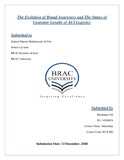The evolution of brand awareness and the status of customer loyalty of ACI Logistics

View/
Date
2018-12-13Publisher
BRAC UniversityAuthor
Pal, ShrabaneeMetadata
Show full item recordAbstract
This internship paper is mainly written on the ACI Logistics (Shwapno), the number one retail chain of Bangladesh which stated its journey in 2008 and it is one of the main parts of ACI conglomerates. Shwapno is the platform where people love to shop, work and invest. The main target of Shwapno is to win the minds and hearts of the customer by integrating the idea of “Every day Better Life”. The main potencies of Shwapno are the customer- obsession, pragmatic decisions, innovative technology, creativity and perfectionism in customer experience. The main strategy of Shwapno is to source fresh food and fish from growers which assists them to keep their dreams alive and offering it directly to the customer. In this paper, at first, the detail informations about retail industry and ACI Logistics (Shwapno) are given to find out the recent position of the ACI Logistics (Shwapno) in the super market industry in compare with other super stores. Then, marketing mix (4P) of Shwapno is analyzed to get a brief idea about the product, price, promotion and place of it. In addition, the SWOT is also added in this paper to understand the strength, weakness, opportunity and threats of Shwapno. Porter’s Five Force is examined to find out the position of the Shwapno in the market place. As the paper is mainly focused on the brand awareness and customer loyalty, that’s why the characteristics of the brand, Shwapno is also added briefly in this paper. After that, the method of data selection process is analyzed to achieve the aim of evaluating brand awareness and the status of customer loyalty of ACI Logistics (Shwapno). For collecting data, online survey is conducted based on 15 questions and sample size is 80 respondents. To do in depth analysis, one hypothesis is made to find out whether the higher brand awareness leads to higher customer loyalty or not. Through Statistical Package for the Social Sciences (SPSS) software, the analysis is done where there is one independent variable (Brand Awareness) and one dependent variable (Customer Loyalty). Here, three concepts are highlighted Reliability, Validity of the variables and the items under them as well as the Regression. In reliability, the consistency of the items under the variables are measured where it can be found that the values of Cronbach’s Alpha for two variables are higher than .7 which shows that the items are reliable. The validity of the variables are also measured where convergent validity proves that the inter item correlation is higher than the intra item correlation and through discriminant validity it shows that two variables brand awareness and customer loyalty is distinct. Through regression, it can be proved that the model is significant and the hypothesis is statistically supported which means if brand awareness will increase then the customer loyalty will also
P a g e | 6
increase. Based on this hypothesis and the survey results, some findings are noted such as most of the people came to know about Shwapno through newspaper, then only 62% people thought it is a trustworthy brand , after that only 28.7% people will choose Shwapno over other superstores. In addition, 42.5% people will recommend Shwapno to near and dear ones. Based on this interesting results and findings, some recommendations are suggested to Shwapno so that it will can increase the brand awareness, which can attach people mentally and emotionally to Shwapno. There is also a scope for further research as the respondents number is limited and the only one hypothesis along with two variables are materialized so there can be a chance of emergence of other variables. In the end, it can be said that, still now Shwapno is the market leader in the super market industry and to sustain this position, Shwapno needs to work on the brand awareness so that large amount of people become aware about the brand which leads to customer loyalty.
